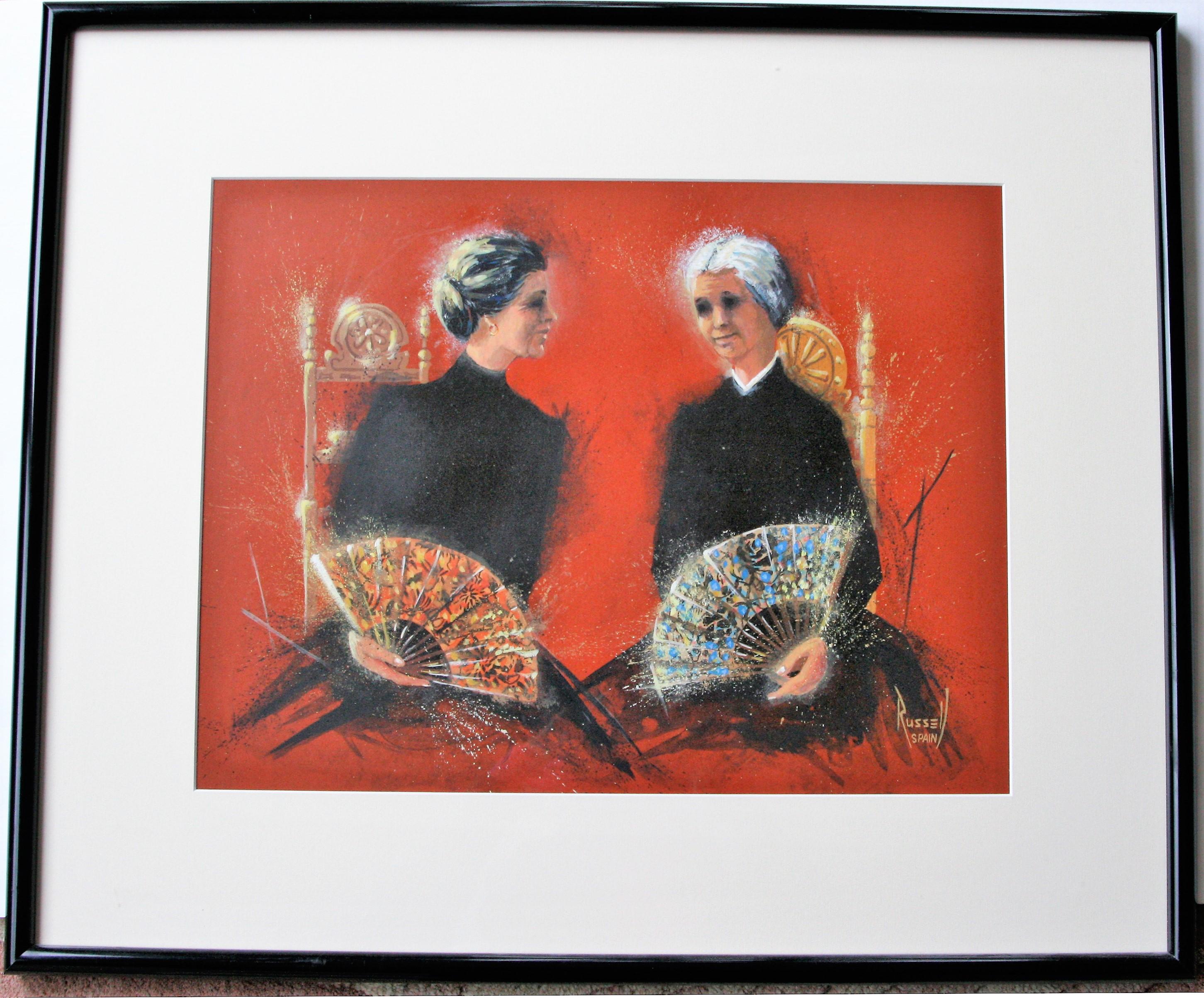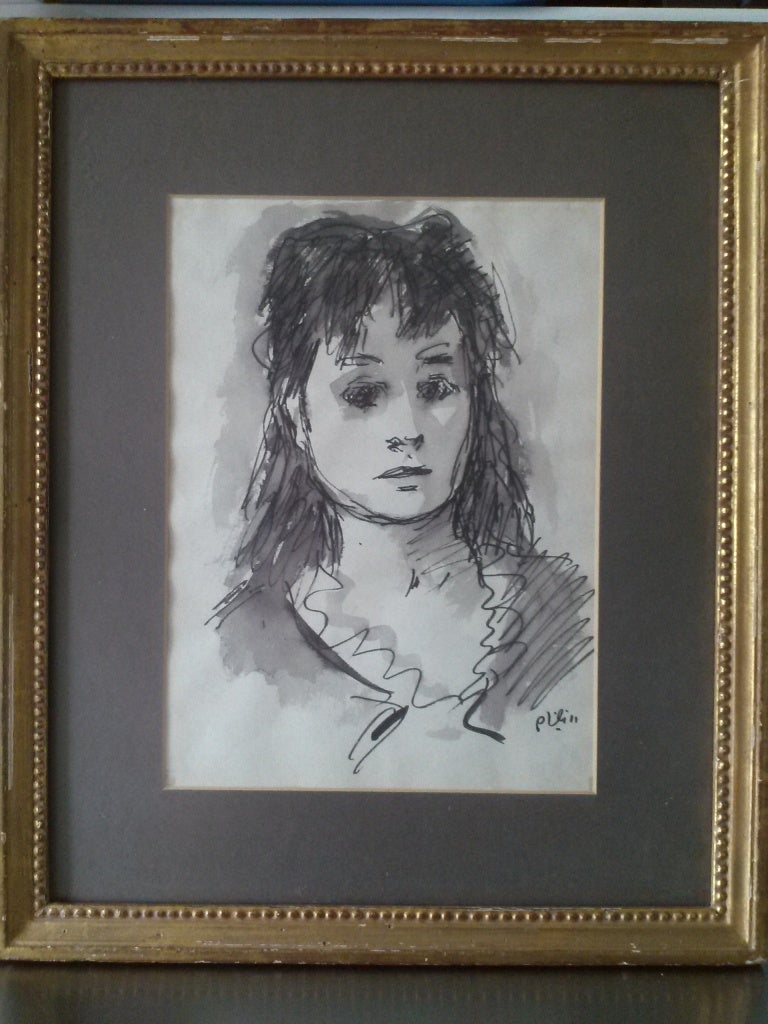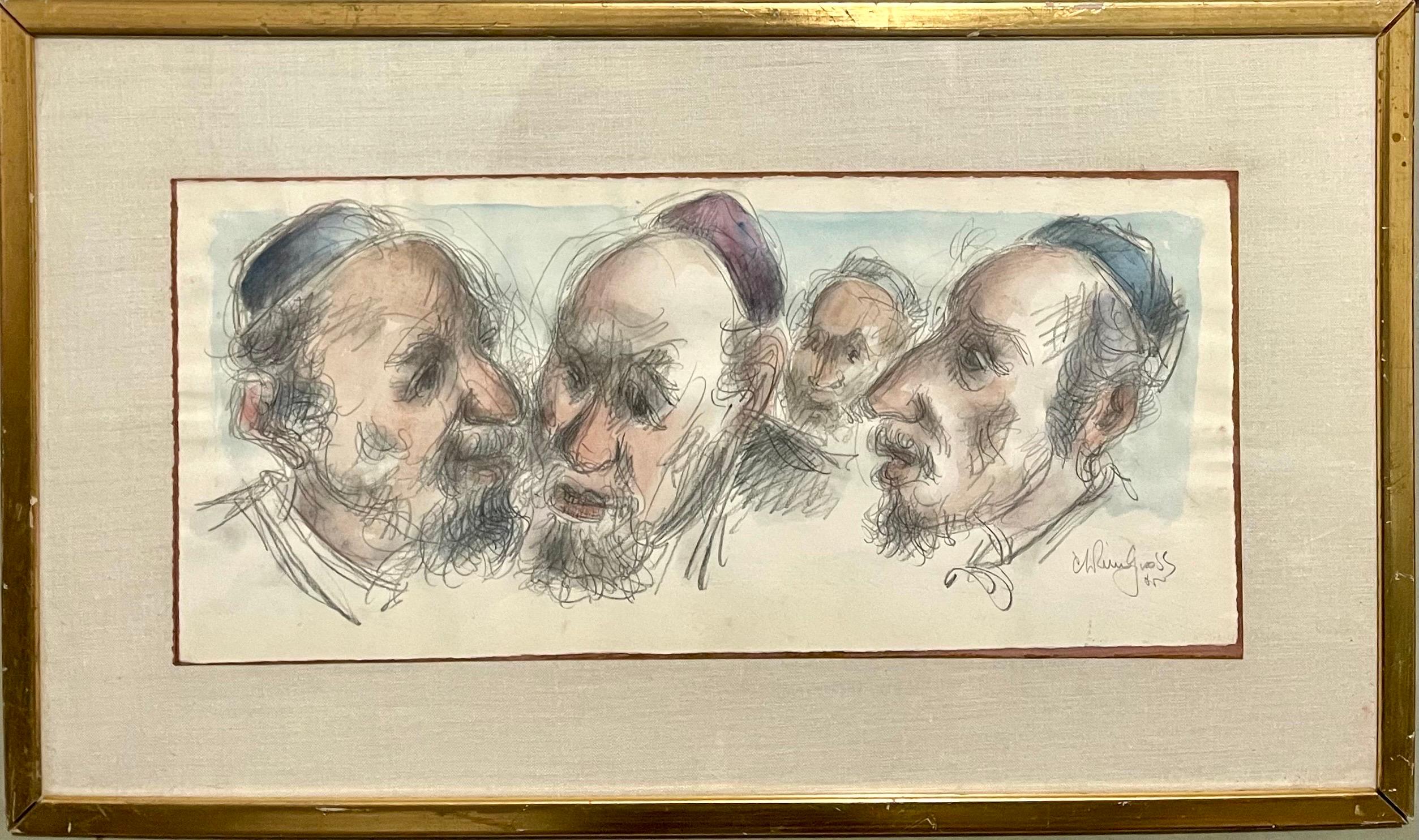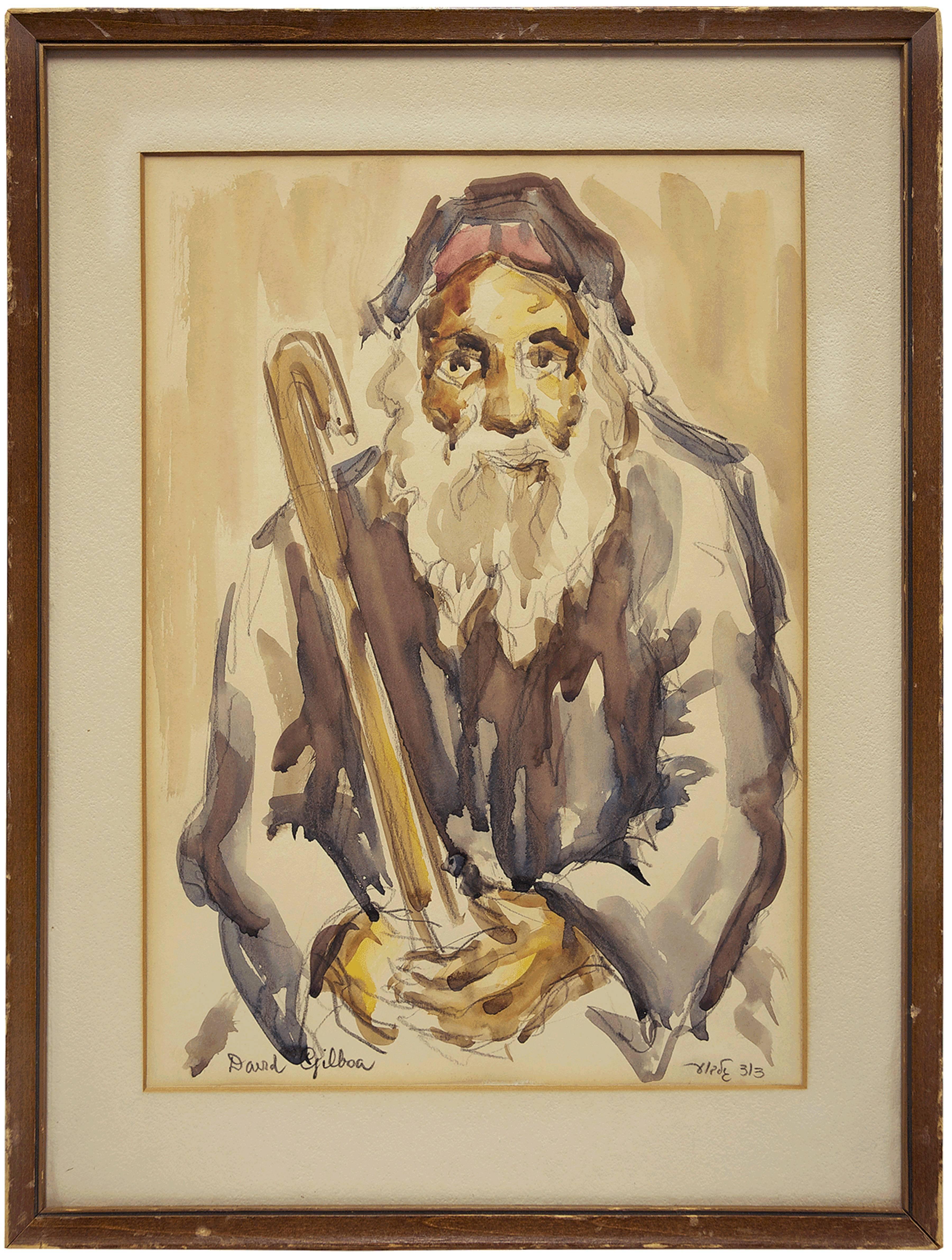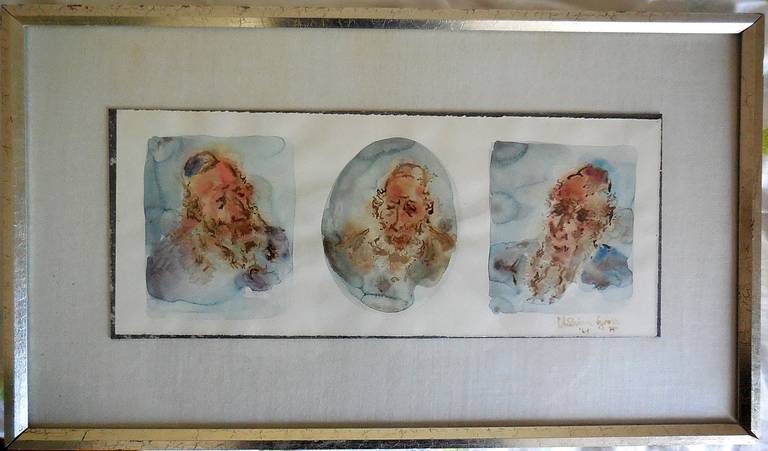Items Similar to James Lewis - 1985 Watercolour, Patroclus' Blood I
Want more images or videos?
Request additional images or videos from the seller
1 of 9
James LewisJames Lewis - 1985 Watercolour, Patroclus' Blood I1985
1985
About the Item
A very precise watercolour painting with gouache and graphite, depicting a surreal scene with three figures, possibly alluding to the Greek mythological story of Patroclus and Achilles. Monogrammed and dated to the lower right-hand quadrant. There is a label on the reverse inscribed with the title. Well-presented in a card mount and in a light wooden frame. On watercolour paper.
- Creator:
- Creation Year:1985
- Dimensions:Height: 25.99 in (66 cm)Width: 27.76 in (70.5 cm)
- Medium:
- Period:
- Condition:Painting in fine condition. Some minor marks and trapped dirt to the mount. Some scuffs and abrasion marks to the frame, as well as slight widening of the corner joints.
- Gallery Location:Corsham, GB
- Reference Number:
About the Seller
4.9
Platinum Seller
These expertly vetted sellers are 1stDibs' most experienced sellers and are rated highest by our customers.
Established in 2010
1stDibs seller since 2018
857 sales on 1stDibs
Typical response time: 5 hours
- ShippingRetrieving quote...Ships From: Corsham, United Kingdom
- Return PolicyA return for this item may be initiated within 30 days of delivery.
More From This SellerView All
- 20th Century Gouache - The CouncilLocated in Corsham, GBAn impressively sized Indian gouache, showing a council of men listening intently to their leader who sits in a wooden pergola in a beautiful garden. Th...Category
21st Century and Contemporary Portrait Drawings and Watercolors
MaterialsGouache
- J. H. - Late 19th Century Watercolour, Sewing LessonLocated in Corsham, GBA beautiful moment between grandmother and granddaughter, captured in watercolour. The woman watches closely as the little girl delicately tries to thread a needle. This heartwarming...Category
19th Century Portrait Drawings and Watercolors
MaterialsWatercolor
- 20th Century Gouache - Vishnu In The Pleasure GardensLocated in Corsham, GBA striking and impressively sized Indian gouache scene showing the god Vishnu in a beautiful garden with ponds full of water lilies. Beautiful women pla...Category
21st Century and Contemporary Portrait Drawings and Watercolors
MaterialsGouache
- Donald Wood - Contemporary Gouache, A French GeneralLocated in Corsham, GBWell presented in a gilt effect frame. Signed and inscribed. On paper.Category
21st Century and Contemporary Portrait Drawings and Watercolors
MaterialsGouache
- Joseph W. Topham Vinall (1873-1953) ARCA, FRSA - Watercolour, After The CatchLocated in Corsham, GBA delightful watercolour depicting two fishermen relaxing in a seaside cabin after a day at sea. The elder of the two lights his pipe and the younger man looks on. Well presented in ...Category
Early 20th Century Portrait Drawings and Watercolors
MaterialsWatercolor
- William Henry Hunt (1790-1864) - Watercolour, Cavalier Seated by StepsBy William Henry HuntLocated in Corsham, GBA charming study of a Cavalier seating on street side steps with his head resting in his hand. The artist captures the young man in fine detail, paying attention to the soft, natural...Category
Early 19th Century Portrait Drawings and Watercolors
MaterialsWatercolor
You May Also Like
- Oriental Woman, Nineteenth Watercolor, Signature To IdentifyLocated in SAINT-OUEN-SUR-SEINE, FROriental woman. 19th century watercolor. Signature to be identified. Framed and under glass. Watercolor (at sight): 20.5 x 10 cm Frame: 33.5 x 23 cmCategory
19th Century Portrait Drawings and Watercolors
MaterialsWatercolor
- Two Dueñas.By Donn RussellLocated in Storrs, CTTwo Dueñas. c. 1960. Watercolor and gouache. 13 x 17. Signed and annotated 'SPAIN' lower right. Housed in a 21 x 25-inch black wood frame. Donn Russell is one of Nantucket Island's...Category
1950s American Modern Portrait Drawings and Watercolors
MaterialsWatercolor, Gouache
- Beautiful Woman watercolor painting by Robert PhilippBy Robert PhilippLocated in Surfside, FLA sensitive portrait beautifully rendered in watercolor and gouache. Mid century. I am guessing from the 1940s it is not dated. Robert Philipp (February 2, 1895 – November 22, 1981) was an American painter influenced by Impressionism and Post-Impressionism, and known for his nudes, still lifes, and portraits of attractive women and Hollywood stars. Noted art critic Henry McBride called Philipp one of America's top six painters of his generation. He was an instructor of painting at the Art Students League of New York for 33 years. WPA Era. Philipp was Secretary of the National Academy of Design, and National Academician, Benjamin Franklin Fellow, Royal Society of Arts in London. He was married to model and fellow artist Rochelle ("Shelly") Post, who frequently posed for him until her death in 1971. His compositions and painting style have been compared to the art of Edgar Degas and Pierre-Auguste Renoir. Philip won prizes in most of the important exhibitions of his time, and his paintings are in numerous museums and important private collections. In 1940, Philipp was invited to Los Angeles by Hollywood mogul Louis B. Mayer to paint portraits of Metro-Goldwyn-Mayer movie stars. The same year, Walter Wanger, producer of The Long Voyage Home, directed by John Ford and based on plays by Eugene O'Neill, contracted with Reeves Lewenthal, head of the Associated American Artists gallery in Manhattan, to bring nine well-known artists to the set and paint scenes from the movie and portraits of the actors in character. The artists included Robert Philipp, Thomas Hart Benton, Grant Wood, Ernest Fiene, George Schreiber, Luis Quintanilla...Category
1940s Portrait Paintings
MaterialsWatercolor, Gouache
- Chaim Gross Mid Century Mod Judaica Jewish Watercolor Painting Rabbis WPA ArtistBy Chaim GrossLocated in Surfside, FLChaim Gross (American, 1904-1991) Watercolor painting Rabbinical Talmudic Discussion Hand signed 17 x 29 framed, paper 10 x 22 Chaim Gross (March 17, 1904 – May 5, 1991) was an American modernist sculptor and educator. Gross was born to a Jewish family in Austrian Galicia, in the village of Wolowa (now known as Mezhgorye, Ukraine), in the Carpathian Mountains. In 1911, his family moved to Kolomyia (which was annexed into the Ukrainian USSR in 1939 and became part of newly independent Ukraine in 1991). When World War I ended, Gross and brother Avrom-Leib went to Budapest to join their older siblings Sarah and Pinkas. Gross applied to and was accepted by the art academy in Budapest and studied under the painter Béla Uitz, though within a year a new regime under Miklos Horthy took over and attempted to expel all Jews and foreigners from the country. After being deported from Hungary, Gross began art studies at the Kunstgewerbeschule in Vienna, Austria shortly before immigrating to the United States in 1921. Gross's studies continued in the United States at the Beaux-Arts Institute of Design, where he studied with Elie Nadelman and others, and at the Art Students League of New York, with Robert Laurent. He also attended the Educational Alliance Art School, studying under Abbo Ostrowsky, at the same time as Moses Soyer and Peter Blume. In 1926 Gross began teaching at The Educational Alliance, and continued teaching there for the next 50 years. Louise Nevelson was among his students at the Alliance (in 1934), during the time she was transitioning from painting to sculpture. In the late 1920s and early 1930s he exhibited at the Salons of America exhibitions at the Anderson Galleries and, beginning in 1928, at the Whitney Studio Club. In 1929, Gross experimented with printmaking, and created an important group of 15 linocuts and lithographs of landscapes, New York City streets and parks, women in interiors, the circus, and vaudeville. The entire suite is now in the collection of the Philadelphia Museum of Art. Gross returned to the medium of printmaking in the 1960s, and produced approximately 200 works in the medium over the next two decades. For more than sixty years Chaim Gross's art has expressed optimistic, affirming themes, Judaica, balancing acrobats, cyclists, trapeze artists and mothers and children convey joyfulness, modernism, exuberance, love, and intimacy. This aspect of his work remained consistent with his Jewish Hasidic heritage, which teaches that only in his childlike happiness is man nearest to God. In March 1932 Gross had his first solo exhibition at Gallery 144 in New York City. For a short time they represented Gross, as well as his friends Milton Avery, Moses Soyer, Ahron Ben-Shmuel and others. Gross was primarily a practitioner of the direct carving method, with the majority of his work being carved from wood. Other direct carvers in early 20th-century American art include William Zorach, Jose de Creeft, and Robert Laurent. Works by Chaim Gross can be found in major museums and private collections throughout the United States, with substantial holdings (27 sculptures) at the Hirshhorn Museum and Sculpture Garden. A key work from this era, now at the Smithsonian American Art Museum, is the 1932 birds-eye maple Acrobatic Performers, which is also only one and one quarter inch thick. In 1933 Gross joined the government's PWAP (Public Works of Art Project), which transitioned into the WPA (Works Progress Administration), which Gross worked for later in the 1930s. Under these programs Gross taught and demonstrated art, made sculptures that were placed in schools and public colleges, made work for Federal buildings including the Federal Trade Commission Building, and for the France Overseas and Finnish Buildings at the 1939 New York World's Fair. Gross was also recognized during these years with a silver medal at the Exposition universelle de 1937 in Paris, and in 1942, with a purchase prize at the Metropolitan Museum of Art's "Artists for Victory" exhibition for his wood sculpture of famed circus performer Lillian Leitzel. In 1949 Gross sketched Chaim Weizmann, Israeli President, at several functions in New York City where Weizmann was speaking, Gross completed the bust in bronze later that year. Gross returned to Israel for three months in 1951 (the second of many trips there in the postwar years) to paint a series of 40 watercolors of life in various cities. This series was exhibited at the Jewish Museum (Manhattan) in 1953. He also did some important Hebrew medals. In the 1950s Gross began to make more bronze sculptures alongside his wood and stone pieces, and in 1957 and 1959 he traveled to Rome to work with famed bronze foundries including the Nicci foundry. At the end of the decade Gross was working primarily in bronze which allowed him to create open forms, large-scale works and of course, multiple casts. Gross's large-scale bronze The Family, donated to New York City in 1991 in honor of Mayor Ed Koch, and installed at the Bleecker Street Park at 11th street, is now a fixture of Greenwich Village. In 1959, a survey of Gross's sculpture in wood, stone, and bronze was featured in the exhibit Four American Expressionists curated by Lloyd Goodrich at the Whitney Museum of American Art, with work by Abraham Rattner, Doris Caesar, and Karl Knaths. In 1976, a selection from Gross's important collection of historic African sculpture, formed since the late 1930s, was exhibited at the Worcester Art Museum in the show The Sculptor's Eye: The African Art Collection of Mr. and Mrs. Chaim Gross. Gross was elected into the National Academy of Design as an Associate member, and became a full Academician in 1981. In 1984, he was inducted into the American Academy of Arts and Letters, with Jacob Lawrence and Lukas Foss. In the fall of 1991, Allen Ginsberg gave an important tribute to Gross at the American Academy of Arts and Letters, which is published in their Proceedings. In 1994, Forum Gallery, which now represents the Chaim Gross estate, held a memorial exhibition featuring a sixty-year survey of Gross's work.In March 1932 Gross had his first solo exhibition at Gallery 144 in New York City. For a short time they represented Gross, as well as his friends Milton Avery, Moses Soyer, Ahron Ben-Shmuel and others. Gross was primarily a practitioner of the direct carving method, with the majority of his work being carved from wood. Other direct carvers in early 20th-century American art include William Zorach, Jose de Creeft, and Robert Laurent. Works by Chaim Gross can be found in major museums and private collections throughout the United States, with substantial holdings (27 sculptures) at the Hirshhorn Museum and Sculpture Garden. A key work from this era, now at the Smithsonian American Art Museum, is the 1932 birds-eye maple Acrobatic Performers, which is also only one and one quarter inch thick. In 1933 Gross joined the government's PWAP (Public Works of Art Project), which transitioned into the WPA (Works Progress Administration), which Gross worked for later in the 1930s. Under these programs Gross taught and demonstrated art, made sculptures that were placed in schools and public colleges, made work for Federal buildings including the Federal Trade Commission Building, and for the France Overseas and Finnish Buildings at the 1939 New York World's Fair. Gross was also recognized during these years with a silver medal at the Exposition universelle de 1937 in Paris, and in 1942, with a purchase prize at the Metropolitan Museum of Art's "Artists for Victory" exhibition for his wood sculpture of famed circus performer Lillian Leitzel. In 1949 Gross sketched Chaim Weizmann, President of Israel, at several functions in New York City where Weizmann was speaking, Gross completed the bust in bronze later that year. Gross returned to Israel for three months in 1951 (the second of many trips there in the postwar years) to paint a series of 40 watercolors of life in various cities. This series was exhibited at the Jewish Museum (Manhattan) in 1953. In the 1950s Gross began to make more bronze sculptures alongside his wood and stone pieces, and in 1957 and 1959 he traveled to Rome to work with famed bronze foundries including the Nicci foundry. At the end of the decade Gross was working primarily in bronze which allowed him to create open forms, large-scale works and of course, multiple casts. Gross's large-scale bronze The Family, donated to New York City in 1991 in honor of Mayor Ed Koch, and installed at the Bleecker Street Park at 11th street, is now a fixture of Greenwich Village. In 1959, a survey of Gross's sculpture in wood, stone, and bronze was featured in the exhibit Four American Expressionists curated by Lloyd Goodrich at the Whitney Museum of American Art, with work by Abraham Rattner, Doris Caesar, and Karl Knaths. In 1976, a selection from Gross's important collection of historic African sculpture, formed since the late 1930s, was exhibited at the Worcester Art Museum in the show The Sculptor's Eye: The African Art Collection of Mr. and Mrs. Chaim Gross. Gross was elected into the National Academy of Design as an Associate member, and became a full Academician in 1981. In 1984, he was inducted into the American Academy of Arts and Letters, with Jacob Lawrence and Lukas Foss. In the fall of 1991, Allen Ginsberg gave an important tribute to Gross at the American Academy of Arts and Letters, which is published in their Proceedings. In 1994, Forum Gallery, which now represents the Chaim Gross estate, held a memorial exhibition featuring a sixty-year survey of Gross's work. Gross was a professor of printmaking and sculpture at both the Educational Alliance and the New School for Social Research in New York City, as well as at the Brooklyn Museum Art School, the MoMA art school, the Art Student's League and the New Art School (which Gross ran briefly with Alexander Dobkin...Category
Mid-20th Century American Modern Figurative Drawings and Watercolors
MaterialsPaper, Watercolor
- Old Rabbi Holding a CaneBy David GilboaLocated in Surfside, FLDavid Gilboa (1910-1976). David Gilboa was born in Romania in 1910. He studied at Academy of Fine Art, Bucharest, Romania, during the years of 1927-29. He immigrated to Israel in 193...Category
20th Century Portrait Drawings and Watercolors
MaterialsWatercolor
- The Rabbis, Judaica portraitsBy Chaim GrossLocated in Surfside, FLthe piece without the original frame measures 18X7.5 inchesThis is a wonderful watercolor by one of America's most treasured artists, Chaim Gross. Throughout his lifetime Gross has gone through tragedy and a real test of faith however, he has the unique ability to focus and direct his expression to the most joyful and beautiful works of art, such as the present lot. For more than sixty years Chaim Gross's art has expressed optimistic, affirming themes. His acrobats, cyclists, and mothers and children convey joyfulness, exuberance, love, and intimacy. This aspect of his work remained consistent with his Hasidic heritage, which teaches that "only in his childlike happiness is man nearest to God." Chaim Gross, born in Wolowa, Austria in 1904, was educated at the Beaux Arts Institute of Design and at the Art Student's League in New York. Chaim Gross's work was greatly influenced by his experiences during a period of international conflict, World War II. He had moved to Kolomyya from Wolowa to get a better education, but the Germans came to occupy, killing, raping, and looting. Gross and his family were chased from one village to the next. He wrote, "We were sleeping on roofs and in the fields, with the sound of cannon fire...Category
1960s Modern Portrait Drawings and Watercolors
MaterialsWatercolor, Archival Paper
Recently Viewed
View AllMore Ways To Browse
Three Figures
James I
Vintage Blood
Lewis Vintage
Greek Mythological
Mythological Portrait
Monogrammed James
Greek Mythological Paintings
Greek Mythological Painting
Achilles Vintage
Achilles And Patroclus
Pencil Portrait Lady
Antique Chalk Portraits
Antique Chalk Portrait
Vintage Pencil Sketch
Unsigned Charcoal
Pere Lachaise
Oval Portraits Drawings

